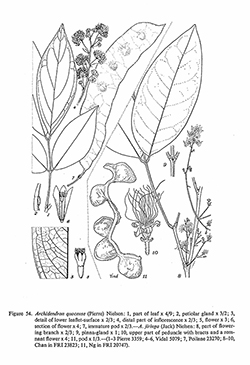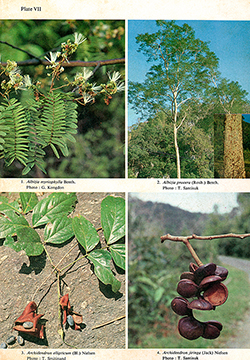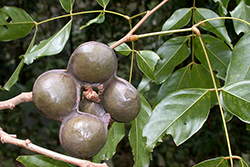e-Flora of Thailand
Volume 4 > Part 2 > Year 1985 > Page 218 > Leguminosae-Mimosoideae > Archidendron
9. Archidendron jiringa (Jack) I.C.Nielsenwfo-0000199807
Adansonia, ser. 2, 19: 32. 1979. Opera Bot. 76: 50. 1985.— Mimosa jiringa Jack, Mal. Misc. 1: 14. 1820.— Inga jiringa (Jack) Jack ex DC., Prod. 2: 439. 1825; G.Don, Gen. Syst. 2: 394. 1832.— Albizzia jiringa (Jack) Kurz, Rep. Pegu, App. B: 47. 1875; J. Asiat. Soc. Bengal 45 (2): 300. 1876.— Pithecellobium jiringa (Jack) Prain, J. Asiat. Soc. Bengal 66 (2): 267. 1897; Craib in Fl. Siam. En. 1: 559. 1928 p.p.; Whitmore, Tree Fl. Mal. 1: 286. 1972.— Zygia jiringa (Jack) Kosterm., Bull. Organ. Natuurw. OndeIz. Indonesië 20: 27. 1954. Fig. 54: 8–11; Plate VII: 4.
Accepted Name : This is currently accepted.
Synonyms & Citations :
Description : Tree up to 20 m high; branchlets terete, glabrous. Leaves: rachis 2–7 cm, gland (s) ca 0.5 cm above the base of the petiole and between the junctions of the pinnae, 1.5–2 mm diam., subsphaerical to flat and circular, sessile; pinnae 1 pair, up to 20 cm, glands (often absent) between the junctions of the petiolules, 0.75–1 mm diam., flat, circular, sessile; leaflets 2–3 pairs per pinna, petiolulate, opposite, chartaceous, up to 8–15 by 4–5 cm, ovate-elliptic to oblong; base broadly rounded to broadly cuneate, apex acuminate; both surfaces glabrous, lateral veins prominulous, not forming a dense reticulation. Inflorescence: panicles in the axils of the upper leaves, or below the leaves, at the leaf-scars on the older branches; peduncles ca 3 mm bearing heads of 4–7 sessile flowers. Calyx 1–2 mm, broadly campanulate to cup-shaped, faintly puberulous, with 0.25–0.3 mm, deltoid teeth. Corolla 4–5 mm, tube glabrous, with ca 2 mm ovate-elliptic acute, reflexed lobes with distinct veins, lobes faintly puberulous to glabrous. Staminal tube as long as the corolla tube. Ovary ca 1 mm, glabrous; stipe ca 2 mm. Pod: up to 20–25 by 4 cm, compressed, falcate or twisted in a wide spiral more or less deeply lobed along the ventral suture between the seeds, woody, greyish outside and inside, glabrous, dehiscent along the ventral suture. Seeds fill the pod, ca 35 mm diam., and 10 mm thick, biconvex, circular, with a dark brown, thin testa.
Thailand : NORTHERN: Chiang Mai, Lamphun Mae Hong Son, Tak; SOUTH-EASTERN: Chon Buri, Chanthaburi, Trat; SOUTH-WESTERN: Kanchanaburi; PENINSULAR: Surat Thani, Songkhla, Narathiwat, Ranong, Phangnga, Trang.
Distribution : Burma, Malay Peninsula, Sumatra (type), Java, Borneo.
Ecology : Evergreen forests, sea level to ca 1,300 m alt.
Vernacular : Khang daeng (ขางแดง)(Central); cha niang (ชะเนียง)(Southeastern); niang (เนียง), niang nok (เนียงนก), pha niang (พะเนียง)(Peninsulal).
Uses: Seeds can be eaten when cooked as the cooking-process destroys the djenkol acid which is poisonous to the kidneys.



